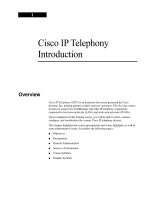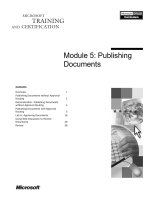Tài liệu Ethernet Native LAN Extensions docx
Bạn đang xem bản rút gọn của tài liệu. Xem và tải ngay bản đầy đủ của tài liệu tại đây (1.95 MB, 8 trang )
WHITE PAPER
Ethernet Native LAN Extensions
Solutions for the Enterprise
Ethernet Native
LAN Extensions
Solutions for the Enterprise
Overview
In today’s fast paced economic climate, enterprise companies are continually
pressured to do more with less, yet they are expanding their reach nationally
and globally at a record pace. The corporate network is being stretched like
never before. New applications such as video conferencing and monitoring,
file sharing, and Voice over IP (VoIP) demand more bandwidth. Regulatory
requirements are putting pressure on IT resources for compliance, and remote
locations need to receive the same application support and resources as the
corporate network – all without increasing cost. The network has become
a critical tool and most corporate IT departments are looking to Ethernet as
a solution to help meet the growing list of demands. Ethernet Native LAN
extensions allow corporations to remove capital and operational costs from
their existing network infrastructure. New technologies that deliver higher
bandwidth at a lower cost per megabit are now available and becoming widely
deployed. This paper will discuss how Enterprise companies can use Ethernet
Native LAN extension platforms to cost effectively deliver multiple applications
and more bandwidth to all locations, regardless of where they are located.
Ethernet Native LAN Extensions - Solutions for the Enterprise
Page 3
Native LAN Extension
Native LAN Extension gives enterprise companies the ability to connect their LANs together in such a way that the
network is transparent to physical boundaries. All of the LANs appear as if they were connected on the same network
regardless of location. Additionally, Native LAN Extension allows enterprise IT managers to leverage the speed and
simplicity of Ethernet to save both capital costs and operational costs in the network. With Native LAN Extensions,
enterprise companies do not have to learn or manage complex technologies such as SONET/SDH, frame relay or ATM.
They only work with Ethernet, a familiar LAN technology, and leverage a provider’s expertise and resources in wide
area technologies.
Native LAN Extension can be deployed in three types of configurations:
• Point-to-Point
• Point-to-Multipoint
• Multipoint-to-Multipoint
Point-to-Point
The Metro Ethernet Forum (MEF) defines a point-to-point connection as an E-Line Ethernet service type that is based
on a point-to-point Ethernet Virtual Connection (EVC). An E-Line service delivers Ethernet-based LAN services across a
local or metro serving area from one point to another.
Point-to-Multipoint
A point-to-multipoint connection delivers Ethernet-based services across a national or international serving area in a
hub-and-spoke topology. In this topology, a router or switch at the main enterprise hub node would have to supply
the connectivity between the nodes on the end of the spokes.
Multipoint-to-Multipoint
A multipoint-to-multipoint topology uses VLAN tags to deliver differentiated Ethernet services from a single or multiple
customers over a Native LAN. The MEF defines this topology as an E-LAN service, and it is also known as a star
topology. A star network supplies multipoint-to-multipoint connectivity between all customer nodes.
Ethernet Native LAN Extensions - Solutions for the Enterprise
Page 4
Ethernet over T1/E1
T1/E1 lines and frame relay connections are still the primary mode of transport for enterprise companies of all sizes to
reach many of their office locations. But despite its ubiquity in the last mile, frame relay cannot offer the bandwidth,
flexibility, or scalability that Ethernet can. Products are available today that can help enterprise companies leverage
their existing T1/E1 infrastructure to deliver business class Ethernet-based services over these lines in place of frame
relay. Up to 8 T1s can be bonded using the standard Multilink Point-to-Point Protocol (MLPPP) offering up to 12Mb/s
(T1) or 16 Mb/s (E1) of service.
Customer benefi ts include:
• Bonded T1/E1 links provide bandwidth ranging from 1.5 Mb/s to 16 Mb/s and automatic removal/restoration of
failed links.
• Use of existing T1/E1 lines to deliver Ethernet services to all locations.
• Plug and play platform and design.
• Easy access to configure or disable access and ports from anywhere via secure in-band management access from
anywhere on the network.
Core
Bonded T1/E1s
T1/E1
Ethernet
VoIP PBX
Switch/Router
Switch/Router
Example of Ethernet over T1/E1
Ethernet Native LAN Extensions - Solutions for the Enterprise
Page 5
Ethernet over DS3
Most enterprise WAN networks today use DS1 or DS3 connections. Most services in place today that use DS3 circuits
require an all or none approach – either the entire 45 megabits is used or none is. By adding Ethernet services to a
DS3, bandwidth can now be groomed to any increment from sub 10megabits up to 45 megabits, allowing a “pay as
you grow” approach to service.
Customer benefi ts include:
• Use of existing DS3 connections to deliver Ethernet services to all locations.
• Plug and play platform and design.
• Enhanced user traffic classification for better management.
• Easy access to configure or disable access and ports from anywhere via secure in-band management access from
anywhere on the network.
• Delivery of circuit based TDM services via circuit emulation in addition to Ethernet from the same platform.
Switch/
Router
Switch/
Router
Switch/
Router
Ethernet
Ethernet
Ethernet
VoIP PBX
Traditional PBX
Ethernet
T1
GigE
Regional Office or HQ
Remote Sites
T1s
PBX
PSTN
IP/MPLS
DS3
DS3
DS3
Transport
Network
Site 1
Site 2
Site 3
Example of Ethernet over DS3









